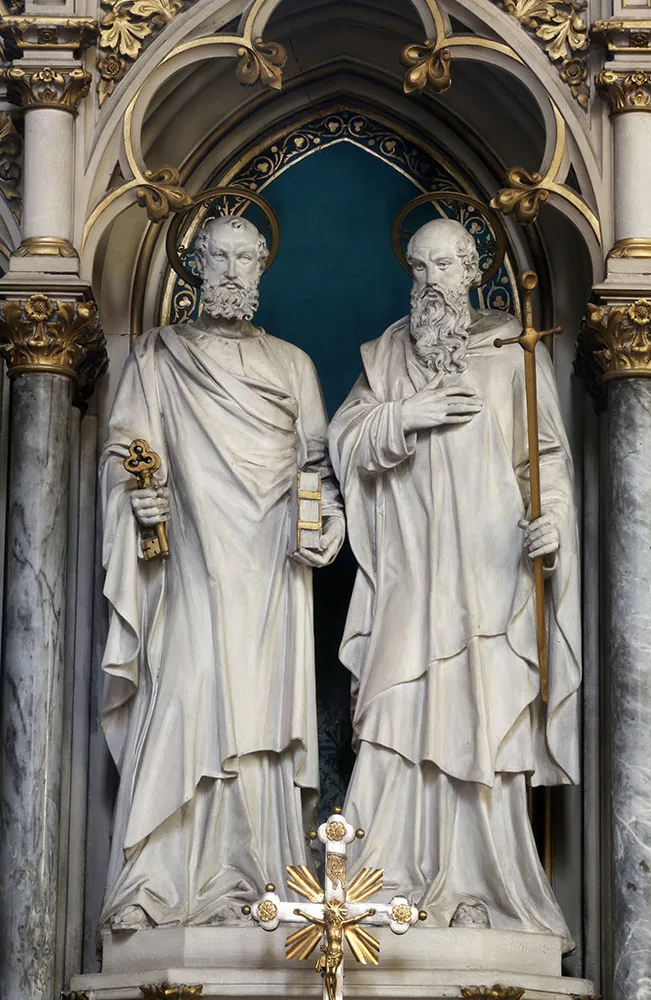After the descent of the Holy Spirit at Pentecost, the early Church expanded rapidly within Judaism. With its expansion came persecution from the Jewish authorities, but the Church continued to grow in numbers. Driven from Jerusalem, the Apostles started to form more Christian communities throughout Judea. Eventually, through the conversion of St. Paul, Christian communities began to form in Gentile territory as well. With the decision of the Council of Jerusalem in the year 50 AD, new converts did not have to adhere to external Jewish customs (circumcision and abstaining from unclean meat) to become Christian. Thus, the Christian community was truly becoming Catholic or universal.
This expansion largely happened through the missions of Sts. Peter and Paul. Both originate in Jerusalem (Peter at Pentecost and Paul as a persecutor of Christianity), and both die a martyrs’ death in Rome. While little is known for sure about Peter’s mission after the Council of Jerusalem, Paul’s journeys are well documented.
St. Paul went on three missionary journeys that are recorded in scripture. On these journeys, Paul went through Cyrus, Pamphylia, Galatia, Achaia, Asia, and Macedonia. He founded many Christian communities, discipled and set up leaders, and wrote them letters admonishing and encouraging them to remain faithful followers of Jesus and the teachings of the Apostles. In addition, Paul endured much persecution. He was thrown into prison frequently, flogged and beaten with rods on numerous occasions, and was stoned close to death. He was even shipwrecked and drifting afloat at sea for 24 hours. Despite all of this, Paul made his way to Rome after being arrested and appealing to the Emperor. The book of Acts of the Apostles ends while Paul is on house arrest in Rome, so we do not know the conclusion of the trial. Some scholars believe it ended in the martyrdom of Paul while others believe that Paul was released, began a 4th missionary journey, and then was arrested again, eventually resulting in his death. Regardless of when it happened, Paul was martyred by beheading during the Roman persecution of Chritsians under the Emperor Nero.
From his journey’s, we get many letters from St. Paul to the communities that he founded. These letters are instructions that have lasted two millennia and comprise the majority of the New Testament in the Bible. From these letters, we learn how the early Christians lived out the New Covenant of God with His people. Divinely inspired, these letters contain instruction, admonishment, and encouragement that speaks in a timeless manner to all Chrisitans.
All that we know of Peter is that his missionary journeys were less expansive as Paul’s. Yet we do know that Peter ended up the first leader of the Church in Antioch, the place where the term Christian was invented. After leaving the Church of Antioch to Evodius and eventually Ignatius of Antioch, Peter and a group of Christians traveled from Antioch to Rome, preaching as they went. Once in Rome, they founded the church there with Peter as the head. As persecutions raged after the great fire of Rome that Nero blamed on the Christians, tradition has it that Peter was fleeing Rome when He saw Jesus walking back into Rome. Peter asked Jesus where He was going to which Jesus replied, “I am going to Rome to be crucified again.” Peter, filled with courage, returns to Rome and is eventually martyred by being crucified upside down.
As Tertullian tells us: ‘The blood of the martyrs is the seed of the Church.’ Rome exemplifies this as two giants of the faith were killed for their missionary zeal and love of Jesus within its bounds (or right outside the walls). The Roman Empire eventually becomes Christian, and Rome becomes the center of Western Christianity. The bishop of Rome, the successor of Peter, becomes the leader of the Roman Catholic Church because Peter was the rock on which Jesus promised to build His Church. To this day, Rome remains the central site of leadership in the Roman Catholic Church.
Catholics and Protestants alike recognize the heroism of Sts. Peter and Paul and strive to follow their teachings to this day. They remain the two pillars on which the early Church had its foundations. The Church grew from their teachings, and was sanctified from their martyrdom. After their deaths, the Church endured and flourished, reminding all that it is not an institution dependent on remarkable human beings. Rather, it is guided by the power of the Holy Spirit that was given at Pentecost and at each converts baptism. Their martyrdom was not a loss for the Church on earth, but a triumph. For there is no greater love than this, to lay down one’s life for a friend.






